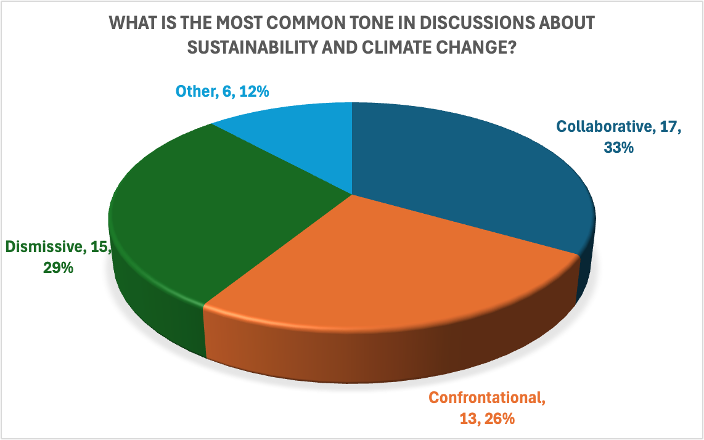Productive Conversations to Enable Green Innovations

Abstract
After listening to people engage in conversations about climate change and sustainability, I became curious to discover how people in my network on the LinkedIn platform would describe their experience and conversational tone when discussing sustainability and climate change. In addition, I inquired whether other research aligned or disagreed with my curiosity and LinkedIn poll results. A Yale University Program on Climate Change Communication (YPCCC) described the approach to understanding public perceptions and behaviors related to climate change, providing insights into how different communication strategies resonate with various audiences. Further, could my discovery help to advance the practice of climate coaching?
A Recent LinkedIn Poll Result

The LinkedIn poll results highlighted the distribution between the survey response options of 1) collaborative, 2) confrontational, 3) dismissive, and 4) other. The results are highlighted in Figure 1.
LinkedIn Poll Question: What is the most common tone when discussing sustainability and climate change?
Comments from People Responding ‘Other’
Mike:
It depends on who you’re talking to, where they live, and how influential the oil and gas industry is in their communities. I live in Texas, so it’s hard to broach this topic with many people who are sensitive to gas prices and feel climate change has not been proven (at least not to their satisfaction).
Nenad:
I don't know. It depends on who's in the conversation (deniers, skeptics, disruptors, etc.).
Anjali:
It depends on who is part of the conversation. I have experienced all three options. In my humble opinion (IMHO), it is an expected response when dealing with the inconvenient truth. But it is hard to be dismissive and uselessly confrontational when a massive hurricane is staring us in the face. The reference to Hurricane Helene. Hurricane Milton followed one week later in Florida.
YPCCC vs The LinkedIn Poll Results
The power of Generative AI was a source for finding and comparing the results of the LinkedIn poll with Yale University’s prominent research. To compare the LinkedIn poll responses with Yale’s Program on Climate Change Communication (YPCCC) research, Generative AI examines the similarities and differences in tone in climate discussions and public perceptions of climate issues.
The YPCCC research identified Global Warming's Six Americas: This study defined segmentations that categorized the American public into six groups based on their climate change beliefs, attitudes, and behaviors:
-
- Alarmed (deeply concerned and highly engaged)
- Concerned (moderately worried but not as engaged)
- Cautious (aware but less engaged)
- Disengaged (unaware or indifferent)
- Doubtful (skeptical about the severity)
- Dismissive (actively rejecting the concept of human-caused climate change)
LinkedIn Poll and YPCCC Research Similarities and Differences
- Collaborative Tone (LinkedIn Responses vs. YPCCC Research)
Similarity:
- The LinkedIn poll results and YPCCC’s research highlight a significant portion of the population engaged in collaborative discussions on sustainability. This collaboration is especially present among individuals who are more alarmed or concerned about climate change and are actively seeking solutions.
Difference:
- The YPCCC research emphasizes the proportion of the population actively engaged in these collaborative efforts, with only about 33% falling into the “Alarmed” or “Concerned” categories. Your LinkedIn poll suggests a relatively higher proportion (based on the 17 responses labeled as "collaborative"). This difference could reflect that the LinkedIn audience may be more engaged or informed about sustainability than the general public YPCCC samples.
- Confrontational Tone (LinkedIn Responses vs. YPCCC Research)
Similarity:
- The LinkedIn poll and YPCCC’s findings recognize the existence of confrontation in climate discussions, especially where there are opposing perspectives on the urgency of climate action. In both cases, the confrontational tone likely arises from conflicting interests, such as economic concerns, political ideology, or varying levels of climate awareness.
Difference:
- YPCCC’s research emphasizes the ideological and political divisions contributing to confrontational tones, especially in the U.S., where climate change discussions are highly polarized. In the LinkedIn responses, the confrontational tone may not be as ideologically driven. It could stem more from differences in approaches to sustainability within industries or businesses rather than outright denial of climate change.
- Dismissive Tone (LinkedIn Responses vs. YPCCC Research)
Similarity:
- The LinkedIn poll and YPCCC’s research identify a dismissive attitude as a barrier to climate discussions. Dismissive people in these conversations may undermine progress by rejecting the urgency of climate issues or questioning the science behind them.
Difference:
- While the YPCCC research focuses heavily on climate denial as a source of dismissive tone (especially from the “Dismissive” and sometimes “Doubtful” segments), the LinkedIn poll responses could include dismissiveness not only from outright climate skeptics but also from people who are fatigued by sustainability discussions or feel overwhelmed by the scale of the problem. Additionally, in professional or corporate settings (like LinkedIn), dismissiveness could come from those prioritizing short-term business interests over long-term sustainability goals rather than from climate change denial.
- “Other” Tone (LinkedIn Responses vs. YPCCC Research)
Similarity:
- The LinkedIn poll and YPCCC’s research show that various tones in climate conversations fall outside the primary categories. These might include less engaged or indifferent tones that still impact the quality of discussions.
Difference:
- The “Other” category in your LinkedIn poll could reflect more nuanced or specific tones unique to professional settings, such as indifference due to competing business priorities or hesitation due to uncertainty about sustainability strategies. In contrast, YPCCC’s research typically categorizes people based on their overall stance on climate change, with fewer granular tones outside collaboration, confrontation, or dismissal.
In summary, there are significant similarities between the LinkedIn poll responses and YPCCC’s research. Both recognize the presence of 1) collaborative, 2) confrontational, and 3) dismissive tones in climate and sustainability discussions, and both highlight how differing levels of climate awareness and concern drive these tones. However, the differences arise in the contexts and nuances of these discussions:
- YPCCC research focuses more on ideological and political divides across broad public perceptions.
- The LinkedIn responses reflected professional or business-focused concerns, where dismissiveness and confrontation could be driven by short-term economic interests or strategic disagreements rather than outright climate denial.
Enhancing Climate Coaching Effectiveness
Effective climate coaching methods empower individuals, teams, and organizations to take meaningful and sustained action on climate change. Climate coaching integrates environmental education with motivational strategies to help people make behavior changes, set goals, and overcome challenges related to climate action.
Combining insights from YPCCC’s segmentation research with the LinkedIn poll results equips climate coaches to understand better how to approach different audiences in sustainability conversations. These insights allow for tailored, empathetic, and effective coaching strategies that address climate discussions’ varying tones, attitudes, and engagement levels. Climate coaches can drive meaningful and productive action across diverse groups by adapting messaging, fostering collaboration, and using empathy and data.
The six areas for climate coaching Impact include:
- Understanding Audience Segmentation (YPCCC’s “Six Americas” and LinkedIn Poll)
- Coaching for Collaborative Problem-Solving
- Navigating Confrontational and Dismissive Tones
- Empathy and Active Listening
- Tailored Messaging and Reframing
- Using Data to Inform Actionable Goals
Conclusion
The tone of climate conversations directly influences policy development, acceptance, and implementation. A collaborative tone fosters consensus and progress, while a confrontational or dismissive tone often results in polarization, delays, or inaction. Ensuring solution-focused and inclusive climate discussions is essential for advancing effective climate policies addressing the global crisis.
